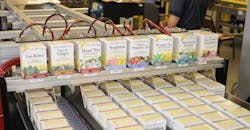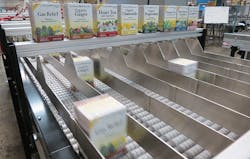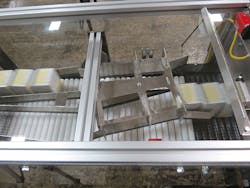Automated End-of-Line Packing Makes for a Smooth Operation
At Traditional Medicinals’ headquarters and manufacturing operations in the Northern California town of Sebastopol, it is all about herbal teas. The company’s co-founder, chairman and chief visionary officer, Drake Sadler, is just as passionate now about passing along the centuries-old wisdom of how to use plants for wellness, as he was when he started the company in the early 1970s. Along the way, Traditional Medicinals has pursued the rigorous process of getting nearly every product certified organic, and many also certified Fair Trade and now Fairwild. The company’s herbalists have crafted over 50 high-quality herbal teas, categorized into nine wellness collections: detox, digestive, green, herbal, laxative, relaxation, seasonal, kids and women’s. Traditional Medicinals was, and continues to be, a pioneer in the wellness tea categories.
Its brands like Nighty Night, Ginger Aid, Chamomile with Lavender, Mother’s Milk and Smooth Move are carried by more than 70,000 big-box and specialty retailers throughout the U.S. and Canada. And the company continues to expand at a sales growth rate of 17-18% annually. This growth necessitated an automated solution to streamline throughput in Traditional Medicinals’ end-of-line packing, which was a highly manual process.
Automated Product Packaging to Manual Case Packing
The company’s packaging process is straightforward and very automated: Its filling equipment measures an exact amount of tea which is put into a tea bag. The bag is stapled closed, and along with a little string attached to a tag, the assembly is inserted into an envelope. Sixteen of these envelopes are put into a carton, put through a checkweigher to confirm the carton’s proper content volume, then glue-sealed for tamper-resistance. At any given point, eight tea SKUs can be run on the filling/packaging machines. But from here, the packing process became a manual operation.
After filling and packaging, the cartons were moved to the company’s end-of-line packing to be case packed. Workers manually applied a label to the cartons, printed in advance, for each of the eight different SKUs. Six cartons of the same tea were then packed into a case. A label was applied to identify the case SKU, and the case was then sealed and stacked onto one of eight pallets of the same product. This process was done, simultaneously, for all eight teas produced on that run.
“We had three individual case packers in place that serviced our three packing lines,” says Bryan Hoffman, director of engineering at Traditional Medicinals. “The packing equipment used a pre-folded corrugated case that we pushed the cartons down into. These case packers were old and presented a lot of issues that impacted our throughput. We wanted one automated solution that would support our growth for the next five years.”
Carton Sortation Solution
Traditional Medicinals selected ARPAC, a manufacturer of end-of-line secondary packaging systems, to engineer a solution. In turn, ARPAC partnered with Shuttleworth, a manufacturer of specialized conveyor systems, to jointly develop an automated system that would take the tea from the filling/packaging process, through case packing and directly to pallet-build with virtually no manual intervention.
Shuttleworth developed a sorting/accumulation conveyor system that would receive the outgoing tea cartons from the filling/packaging process and divert them into eight different lanes, each with a different type of tea.
“Our eight filling machines produce different flavors of tea at different throughput rates,” continues Hoffman. “The cartons come down from the filling/packaging line on one of two lanes. A barcode on the bottom of each package identifies the flavor of tea, which is scanned by the receiving accumulation/sorting conveyor, and directed into one of the sorter’s eight lanes, separated by flavor of tea.”
The 26-foot-long sortation/accumulation conveyor system was designed to accumulate and monitor the volume of the different tea flavors in each of the eight lanes. When any of the lanes fill up to a specified level of cartons, as determined by a sensor in the conveyor, the cartons in those lanes will be released into the case-packer infeed.
The sortation/accumulation conveyor utilizes a technology called Slip-Torque, which eliminates accumulation jam-ups with the tea cartons. It provides low-line pressure, ensuring that the cartons do not get damaged. Should the accumulation line need to slow or stop, the conveyor can continue to take cartons from the upstream line for a specified period of time instead of stopping the line. A low-pressure accumulation buffer absorbs irregularities in the production flow, and provides a smooth, even flow through the line.
The technology utilizes individually-powered rotating roller shafts and loose-fit rollers, which become the conveyor surface, powered by a continuous chain, explains Todd Eckert, regional sales manager for Shuttleworth. “The size and weight of the cartons determine the driving force. When a carton stops on the surface of the conveyor, the segmented rollers beneath the carton also stop.”
The conveyors are able to modulate the speed of different sections of the conveyor, via a central control PLC and HMI, Eckert adds. “As the cartons are moving down the line, the rollers at the back end of the conveyor can be moving faster than the ones at the front end of the conveyor. The tea cartons can be moving at variable speeds on different sections of the conveyor as dictated by throughput requirements.”
Controlling Case Packer Infeed
The sortation/accumulation conveyor releases six cartons at a time from each of two accumulation lanes (12 cartons total), into a 16-foot-long case-packer infeed conveyor. The infeed conveyor is split into two lanes, handling six cartons in each lane, one for each SKU. Release of the cartons from the sortation/accumulation conveyor is controlled by the case packer, which measures the accumulation in each of the lanes and instructs the sortation/accumulation conveyor to release two of the lanes that have at least six cartons.
“Six cartons are being packed to a case,” explains Chuck Mayberry, product manager, director of control systems, robotics and integration at ARPAC. “The case packer is instructing 12 cartons to be released at a time, because this is the most efficient way for it to manage the cartons.
“The case packer is actually controlling and balancing the different amounts of inventory in the system,” Mayberry adds. “The various teas are produced at differing rates, so the system selectively pulls from those lanes of accumulation that are waiting to be case packed, releasing those in two slugs of six cartons. This allows the system to balance case packing with actual production.”
Solid-Case to Wrap-Around Case Packing
The case packer is a wrap-around style case packer. Rather than trying to construct a carton and load it, as Traditional Medicinals had been doing, this forms the carton around the product. It builds an array of the six cartons, then pushes the array onto a blank, which folds a box around the cartons.
The infeed rotates the cartons on their side, for better positioning, before being pushed into the case packer, and verifies the barcodes as they came in. The barcode data allows the case packer to print the corresponding product label which is applied to the case prior to discharge.
Wrap-around case packers can reduce the amount of corrugated board used by up to 25%, with additional savings in warehouse space and lower handling costs. An intermittent motion wrap-around case packer, designed to reach speeds of 25 cases per minute, helps minimize labor requirements while increasing production output. It combines blank feeding, product loading, case forming, labeling and case sealing into a single, compact machine.
“Because it is not trying to load material into a preformed case, the case does not have to be oversized,” Mayberry notes. “It can be exactly the size of the product going inside of it. That can do a couple things: One, it packs the cartons in tight enough to not require dividers in between. Two, because the carton is not oversized, it allows a better utilization of space on a pallet. One-quarter inch of dimension was reduced from Traditional Medicinals’ cases in length and depth. This helps reduce damage caused by products shifting during shipping and handling.”
After packing, the cases are scanned, and discharged from the case packer onto a 12-foot-long sortation conveyer, which routes the cases into one of eight different lanes corresponding to the different product SKUs for pallet builds, and subsequent shipping, but can allow more efficient pallet builds which can reduce shipping costs.
Performance
“The case packing system was installed in April 2014,” says Hoffman. “We have grown over 50% since we put this end-of-line system in place, and have been able to support that growth with the case packer. I would say we have certainly been able to put more throughput into our case packer line.”
The case packer system is rated for 19 cases per minute. Traditional Medicinals has been able to run the system consistently near capacity at peak periods.
“When we purchase a piece of equipment, it is not just about its capabilities,” adds Hoffman. “It is after installation, the support that we get, which has been very good. As we expand, we experience new challenges, and we are very pleased to have partners to help us solve those challenges.”
Jim McMahon writes on packaging automation and is a frequent contributor to MH&L.
About the Author
Jim McMahon
Jim McMahon writes on logistics solutions.


